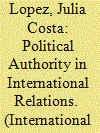| Srl | Item |
| 1 |
ID:
172842


|
|
|
|
|
| Summary/Abstract |
In international relations, accounts of medieval political authority are divided between those who see a heteronomous patchwork of overlapping authorities and those who claim that the era of the state started in the twelfth century. How can we overcome this divide? I argue that IR's current difficulties in grasping the nature of medieval political authority stem from shortcomings in how the notion of political authority itself has been conceptualized. Thus, rather than starting from a substantive definition of political authority, I focus on contestation over the categorization and authorization of rule, that is, on how authority is produced in historically specific ways as a result of contemporary contestation over what political authority is, who is authorized, and how rulers stand in relation to one another. This reorientation allows us to appreciate how medieval political authority emerged from the competition between four sets of ordering categories: iurisdictio, potestas, lord/vassal, and magistrate. Each one of these four categories understood authority, rulers, and the relation between rulers in different ways. The problem with existing accounts of medieval authority is that they attempt to find the single ordering principle of medieval international relations. In doing so, they not only fail to capture the features of the time but also reinforce a particular approach to political authority that is unhelpful for understanding medieval and modern politics alike.
|
|
|
|
|
|
|
|
|
|
|
|
|
|
|
|
| 2 |
ID:
167460


|
|
|
|
|
| Summary/Abstract |
The current combat motivation model based on primary group thesis assumes that the main force behind motivation is peer-bonding or otherwise known as unit cohesion. Cohesion is perceived as an all-encompassing factor that leads to satisfactory (or unsatisfactory in lack thereof) military effectiveness and performance in conflict environments. However, the article identifies three main problems with this perspective: 1. mono-dimensional view of motivation; 2. motivation based on heteronomy, and 3. self-reporting bias. The current model does not consider motivation as a separate entity from cohesion; it does not place motivation as fundamental human value; lastly, it takes motivation as granted by-product of socialization. The article proposes a new combat motivation model based on The Self-Determination Theory. The theory maintains that human motivation requires satisfaction of three psychological needs of competence, relatedness, and autonomy. The degree of satisfaction of those three needs leads to different types of regulated motivations – a continuum from intrinsic to extrinsic – each of which has specifiable consequences for learning, performance, and well-being of an individual.
|
|
|
|
|
|
|
|
|
|
|
|
|
|
|
|